The article „Foam Mattresses: The Ultimate Guide“ provides a comprehensive overview of foam mattresses, highlighting the unique features and benefits of memory foam and polyfoam. It discusses the importance of factors such as density, firmness, and breathability when considering a foam mattress, and outlines the various options available, including gel-infused foam, plant-based foam, and copper-infused foam. Overall, the article emphasizes the diverse range of choices within the foam mattress category to cater to individual comfort and support requirements, offering valuable insights to help readers make informed decisions when selecting a foam mattress that suits their unique sleep needs. Similarly, the article „Demystifying Hybrid Mattresses: What You Need to Know“ delves into the rising popularity of hybrid mattresses, explaining their unique construction and combination of materials to provide a balance of comfort, support, and temperature regulation. It provides an in-depth look at the ability of hybrid mattresses to cater to different sleep preferences, addressing factors such as targeted support, pressure relief, and motion transfer. The article also emphasizes the importance of considering factors such as foam density, coil count, and overall design when evaluating the quality and support offered by a hybrid mattress. Overall, both articles offer valuable insights and guidance for readers in their quest for the perfect mattress, making them essential reads for anyone looking to improve their sleep quality.









